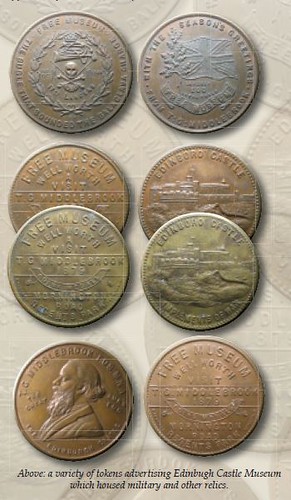
PREV ARTICLE
NEXT ARTICLE
FULL ISSUE
PREV FULL ISSUE
EIGHTEENTH CENTURY LONDON MUSEUM TOKENSDavid Young published a nice article in the December 2014 issue of Coin News on "Museums & Galleries in Eighteenth
Century London." Here are some excerpts. -Editor
 Sir Aston Lever's Holophusicon
The cost of keeping and improving the collection was a constant drain on Lever’s resources, so he took his museum to London where he could charge people to view it. Leicester House in Leicester Square was rented and the collection was spread throughout its 16 rooms and corridors. Lever himself travelled with the collection to ensure its safe arrival in London and the museum opened in February 1775. The charge for admission varied over the years, starting at 5s 3d it was eventually reduced to 2s 6d which Lever still hoped was high enough to keep out the common people. Subscribers could pay two guineas for an annual ticket and the copper token with HOLOPHUSICON on the obverse and Sr. A.L (Sir Aston Lever) on the reverse is probably one of these annual tickets. The Holophusicon became the talk of London and was in its time the largest collection of natural history and miscellany on view. Lever was by now in debt and the entrance money, although substantial, was not sufficient to clear it. He tried to sell the collection as a whole, but no one was interested and his offer to the British Museum was equally unsuccessful. Using his influence Lever managed to obtain an Act of Parliament for a public lottery to dispose of his museum; unfortunately only 8,000 of the proposed 36,000 tickets were sold at £1 each. The winning ticket was held by James Parkinson, a stationer from Blackfriars. Parkinson allowed Lever to remain in Leicester House while he tried to sell the collection; Sir Aston finally left in 1786 and died two years later. Meanwhile, Parkinson having been unsuccessful in selling the collection, moved it to a specially designed building in Blackfriars Road, and although it remained there for some 20 years it did not attract many visitors; eventually it was sold at an auction lasting more than 60 days. Thomas Middlebrook
Middlebrook issued a series of copper tokens to advertise his museum and invited people to visit it free of charge, the tokens may have been used as an entrance ticket. The earliest of the tokens has a bearded bust on the obverse which is most likely Middlebrook himself, the reverse is dated 1879 and has details of the museum and what is on view. The next token has a similar reverse while the obverse has a view of the castle on the mound at Edinburgh; this token is found in brass as well as copper. A third token was undoubtedly issued to celebrate a Christmas, most likely in the 1880s but unfortunately the token is undated. The final token was clearly made to celebrate the diamond jubilee of Queen Victoria in 1897. Middlebrook died in 1907 and in the following year the museum collection was sold at auction. For more information or to subscribe to Coin News, see:
THE BOOK BAZARREWayne Homren, Editor The Numismatic Bibliomania Society is a non-profit organization promoting numismatic literature. See our web site at coinbooks.org. To submit items for publication in The E-Sylum, write to the Editor at this address: whomren@gmail.com To subscribe go to: https://my.binhost.com/lists/listinfo/esylum All Rights Reserved. NBS Home Page Contact the NBS webmaster 
|
